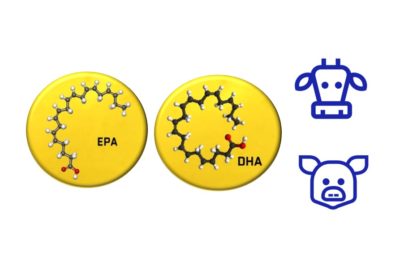Improving fertility in cows and sows with EPA and DHA – NBG Omega

Dear colleagues,
As we have seen in previous publications, omega-3 polyunsaturated fatty acids EPA (eicosapentaenoic acid) and DHA (docosahexaenoic acid) are known for their anti-inflammatory effect.
Their mechanism of action is due to the fact that they compete with omega-6 fatty acids for cyclooxygenase, an enzyme that, if “fed” with EPA and DHA instead of omega-6, produces cytokines with lower inflammatory capacity.
Thanks to this simple mechanism, we can help reduce inflammation or reactivity in animals, particularly in chicks, piglets, dogs, and carnivorous fish, by reducing intestinal inflammation caused by diets high in allergenic vegetable proteins such as soybean meal. In addition to this use, omega-3 fatty acids have also been shown to be useful in helping to reduce joint inflammation and lameness in dogs and sows.
But another well-known use of EPA and DHA is their ability to help increase fertility in cows and sows.
One of the basic mechanisms of this action consists of reducing the production of prostaglandin PG2-Alpha by uterine cyclooxygenases, thereby increasing the life of the corpus luteum and improving embryonic survival.
Finally, we would just like to point out that all the potency of EPA and DHA can easily be lost if the product we use is not properly stabilized. That is why at NBG we have developed NBG Omega, a powdered source of EPA and DHA that is highly stable, easy to store, and highly resistant to temperature and oxidation:
Below we provide one of the first and best studies conducted on dairy cows, which demonstrates improved fertility in cows fed a diet rich in EPA and DHA.
Enjoy the article!

